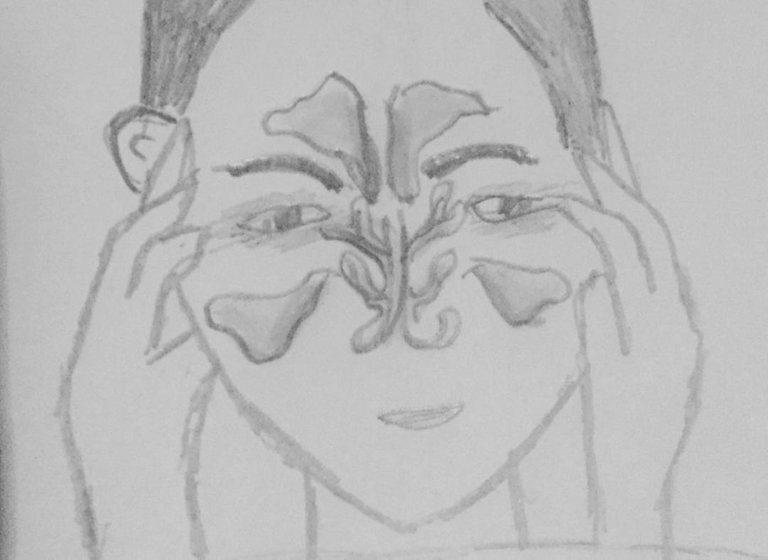Charlemos sobre Rinofaringitis.
Hola amigos de Hive, un placer saludarlos, siempre es un honor poder escribir y compatir con ustedes. Como de costumbre, les deseo salud y bendiciones traducidas en abundancia y prosperidad.
Hoy escribiré un poco sobre rinofaringitis.

La rinofaringitis es una infección que causa inflamación en las vías aéreas superiores específicamente en la la zona nasofaríngea (nariz y faringe).
Esta afección, tiende a ser de carácter virico con mayor frecuencia. Sin embargo, también pueden presentarse cuadros de origen bacteriano.
Es importante destacar que la Organización Mundial de la Salud (OMS), marca en rojo esta patología, y la considera un problema de salud pública ya que presenta una morbilidad bastante alta alrededor del mundo, sobretodo en niños, en cualquier época del año.
Asimismo se señalan los diferentes rinovirus son los que presentan mayor incidencia de esta enfermedad, se estima que entre un 60 o 70% de las rinofaringitis son causadas por rinovirus.
Es importante mencionar que la etilogia de la rinofaringitis es muy importante determinarla, pues los mismos pacientes empiezan a ingerir antibióticos desconociendo la causa del padecimiento, terapia que está contra indicada en esta y cualquier enfermedad de tipo viral.
El mecanismos de transmisión es aeróbico, por lo tanto un individuo se puede contaminar al entrar en contacto con las secreciones producidas por la boca y nariz de un contagiado, aspecto que convierte a esta afección, en una enfermedad de fácil transmisión.
Igualmente tiene un periodo de incubación corto. De hecho, una persona puede manifestar signos o sientas de rinofaringitis después de haber estado en contacto con un individuo contagiado.
Síntomas de la Rinofaringitis:
La rinofaringitis es de comienzo brusco. El paciente puede presentar sintomatología variada, como: Fiebre, dolor de cabeza, dolor en la faringe, estornudos frecuentes, disnea y secreción nasal.
Por otra parte, los signos más comunes, son enrojecimiento alrededor de la nariz, inflamación y enrojecimiento de faringe (si es bacteriana duele venir con placas de pus), goteo nasal, enrojecimiento en ojos.
Diagnóstico:
Tomando en cuenta el alto contagio por Covid-19 y sus diferentes variantes, es muy importante el interrogatorio, que debe ir orientado hacia la parte epidemiologíca ya que mucho de los signos y síntomas coinciden con el Coronavirus.
Así que es importante preguntar, de dónde viene el paciente, en qué trabaja, si ha estado con alguien que haya padecido Covid-19, si ha estado en lugar cerrado, si está vacunado contra el Coronavirus y cuántas dosis tiene, entre otras preguntas.

El examen físico, donde se realice una buena auscultación de pulmones, buscando agregados en las diferentes áreas pulmonares, y de ser posible realizar un test de Prueba Rápida Contra el Covid-19.
Una hematología completa, donde se verá se apreciará el origen de la infección. Allí se verá con mucha atención, los leucocitos, en atención tanto de neutrófilos como de linfocitos para determinar la causa de la Rinofaringitis.
Tratamiento:
Una vez descartada cualquier otra patología, y de ser viral, se indicará tratamiento sintimático, que suele ser acetaminofén, en caso de presentar fiebre o malestar, y algún antihistamínico (loratadina, desloratadina, difenhidramina, ect) agua y reposo.
De igual forma, si la infección es bacteriana, se indicará antibióticos determinado por el médico tratante.
En el mundo actual, la rinofaringitis debe ser tratada con tacto y precaución, tanto por el malestar y molestia que genera al paciente, como por la cantidad de diagnósticos diferenciales que acarrea está afección.

Gracias.
Dios siempre de Cabrestero.
PD: Fotos y dibujos de mi propiedad.
English
Hello friends of Hive, a pleasure to greet you, it is always an honor to be able to write and share with you, as usual I wish you health and blessings translated into health, abundance and prosperity.
Today I will write a little about rhinopharyngitis.
Nasopharyngitis is an infection that causes inflammation in the upper airways, specifically in the nasopharyngeal area (nose and pharynx).
This condition tends to be viral in nature more frequently, however, pictures of bacterial origin can also occur.
It is important to note that the World Health Organization marks this pathology in red, and considers it a public health problem since it presents a fairly high morbidity around the world, especially in children, at any time of the year.
Likewise, it is pointed out that the different rhinoviruses are the ones that present the highest incidence of this disease, it is estimated that between 60 or 70% of rhinopharyngitis are caused by rhinovirus.
It is important to mention that the etiology of rhinopharyngitis is very important to determine, since the same patients begin to ingest antibiotics without knowing the cause of the disease, therapy that is contraindicated in this and any viral-type disease.
The transmission mechanism is aerobic, therefore an individual can be contaminated by coming into contact with the secretions produced by the mouth and nose of an infected person, an aspect that makes this condition an easily transmitted disease.
It also has a short incubation period, in fact a person can show signs or feel of nasopharyngitis after having been in contact with an infected individual.
Symptoms of Nasopharyngitis,:
Rhinopharyngitis is of sudden onset, the patient may present varied symptoms, such as: Fever, headache, pain in the pharynx, frequent sneezing, dyspnea and runny nose.
Likewise, the most common signs are redness around the nose, inflammation and redness of the pharynx (if it is bacterial, it hurts to come with pus plaques), runny nose, redness in the eyes.
Diagnosis:
Taking into account the high contagion by Covid-19 and its different variants, the interrogation is very important, which must be oriented towards the epidemiological part since many of the signs and symptoms coincide with the Coronavirus.
So it is important to ask where the patient comes from, what they work at, if they have been with someone who has suffered from Covid-19, if they have been in a closed place, if they have been vaccinated against the Coronavirus and how many doses they have, among other questions.
The physical examination, where a good lung auscultation was performed, looking for aggregates in the different lung areas, and if possible, perform a Rapid Test Against Covid-19.
A complete hematology, where the origin of the infection will be seen, there will be seen with great attention, the leukocytes, in attention to both neutrophils and lymphocytes to determine the cause of Nanopharyngitis.
Treatment:
Once any other pathology has been ruled out, and if it is viral, symptomatic treatment will be indicated, which is usually acetaminophen, in case of fever or discomfort, and some antihistamine (loratadine, desloratadine, diphenhydramine, etc.) water and rest.
Similarly, if the infection is bacterial, antibiotics determined by the treating physician will be indicated.
In today's world, rhinopharyngitis must be treated with tact and caution, both because of the discomfort and annoyance that it generates for the patient, and because of the number of differential diagnoses that this condition entails.
Thank you.
God always Cabrestero.
Su post ha sido valorado por @ramonycajal